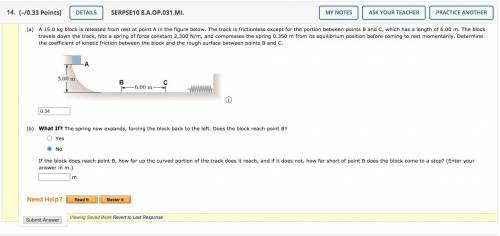
Physics, 16.10.2020 09:01 fshane7705
(A) 15.0 kg block is released from rest at point A in the figure below. The track is frictionless except for the portion between points B and C, which has a length of 6.00 m. The block travels down the track, hits a spring of force constant 2,300 N/m, and compresses the spring 0.350 m from its equilibrium position before coming to rest momentarily. Determine the coefficient of kinetic friction between the block and the rough surface between points B and C.
(B). What If? The spring now expands, forcing the block back to the left. Does the block reach point B?
(Yes or No?)
If the block does reach point B, how far up the curved portion of the track does it reach, and if it does not, how far short of point B does the block come to a stop? (Enter your answer in m.)


Answers: 2
Another question on Physics

Physics, 22.06.2019 14:00
Give an example of a collision in real life. use the law of conservation of energy to describe the transfer of momentum. be sure and discuss the momentum before and after the collision occurs. you will need at least 3 sentences to thoroughly answer this question.
Answers: 1

Physics, 22.06.2019 20:20
The temperature in gavin's oven is a sinusoidal function of time. gavin sets his oven so that it has a maximum temperature of 280°f and a minimum temperature of 240°. once the temperature hits 280°, it takes 20 minutes before it is 280° again. gavin's cake needs to be in the oven for 30 minutes at temperatures at or above 270°. he puts the cake into the oven when it is at 260° and rising. how long will gavin need to leave the cake in the oven? (round your answer to the nearest minute.)
Answers: 3

Physics, 22.06.2019 21:40
Wo small variable-thrust jets are actuated to keep the spacecraft angular velocity about the z-axis constant at ? 0 = 1.16 rad/s as the two telescoping booms are extended from r1 = 1.18 m to r2 = 4.69 m at a constant rate over a period of 124 seconds. the small 19-kg experiment modules at the ends of the booms may be treated as particles, and the mass of the rigid booms is negligible. determine the necessary thrust t for each jet as a function of time where t = 0 is the time when the telescoping action is begun. after you have the general expression for t, answer the questions. show work.
Answers: 1

Physics, 23.06.2019 02:00
Urgent i will give brainliest farmer dantzler brings her prize pig, penny, to the annual country fair. if the mass of the pig is 140 kg, what is the weight? (what are you solving for? what is your formula? what unit do you use to represent weight? you can do it! ) your a.14 g b.140 n c. 1400 kg d. 1372 n show me how to work it too
Answers: 3
You know the right answer?
(A) 15.0 kg block is released from rest at point A in the figure below. The track is frictionless ex...
Questions








SAT, 28.10.2019 09:31

Mathematics, 28.10.2019 09:31



Social Studies, 28.10.2019 09:31

English, 28.10.2019 09:31

Mathematics, 28.10.2019 09:31






Mathematics, 28.10.2019 09:31



